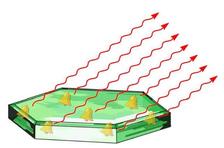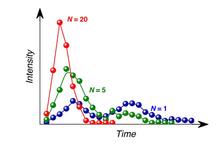An ensemble of many bells can serve as an analogy to the system of atomic nuclei in a crystal, excited by X-rays. (Credit: ESRF, A.I. Chumakov)
An international team, including scientists from DESY, has verified a prediction about the quantum-mechanical behaviour of resonant systems made more than 50 years ago. In experiments at SACLA, the Japanese X-ray laser, and at the European Synchrotron Radiation Facility ESRF in France, the group led by Aleksandr Chumakov from ESRF could show a dramatic reduction in the time to emit the first X-ray photon from an ensemble of excited nuclei when the number of X-rays for the excitation was increased. This behaviour is in good agreement with one limit of a superradiant system, predicted by the US physicist Robert Dicke in 1954, as the scientists report in the journal Nature Physics.
One of the broad challenges of science is to understand the behaviour of groups of atoms based on the response of a single atom in isolation, which is usually much simpler. A facet of this is understanding the behaviour of a group of identical oscillators. An analogy is a collection of bells that all have the same tone: one can easily imagine the sound of a single bell struck once - a clear tone ringing out with a volume that decays away over time.
But what happens if one gently taps all the bells in a large collection? Will the tone be the same as a single one? What about the volume? What about the direction - does it matter where you are standing when you listen to the sound? Does it matter if you tap them all at the same time?
The preceding questions can be answered using some straightforward mathematics. But the analogous questions become more complex when one enters the quantum world of collections of atoms that emit light. In that world, light comes in packets, photons, and the light intensity, analogous to the volume of the bells, is measured in discrete packets of photons. Similar questions arise, but now one also has to ask how the response changes depending on the number of photons, the number of quanta of light, in the system.
A pioneering approach to these issues was developed by Dicke and published in 1954. He predicted a "superradiant" state, where, when large numbers of photons or quanta are put into a system with many atoms, the decay becomes much faster than for a single atom in isolation. In the context of the above analogy, his suggestion would mean that if you have a large number of bells that you excite together, they can ring loudly, but the sound dies out much more quickly than the gentle fading of a single bell.
Dicke's approach included quantum effects, predicting that the fastest decay occurred when the number of quanta was half the number of atoms. The concept of superradiance has since been verified, and, indeed, is a touchstone in the field of quantum optics. However, Dicke also predicted that a very strong change in decay rate would occur even when the number of quanta in the system is much less than the number of atoms in the system. This is what was investigated in recent experiments at the SACLA free-electron laser and at the ESRF.
The new work replaced the low-energy quanta envisioned by Dicke with high-energy X-rays, allowing the decay of the system to be followed one quantum of X-ray light at a time. However, getting strong pulses of X-rays is much harder than for low energy light, and only modern research light sources like X-ray free-electron lasers (XFEL) have made such experiments possible.
With the X-ray laser SACLA the scientists excited an iron borate crystal and recorded the subsequent emission from the iron nuclei photon by photon. In these experiments, the accelerated emission of the first photon was observed to be in excellent agreement with Dicke's prediction. The single-photon decay under the same experimental conditions was studied at the ESRF. From these experiments, an alternative picture of the decay properties was produced based on a statistical approach, which will be valuable for the understanding of future work.
Scientists from ESRF, the Russian National Research Centre Kurchatov Institute in Moscow, RIKEN SPring-8 Center in Japan, DESY, Argonne National Laboratory in the U.S. and the Japan Synchrotron Radiation Research Institute were involved in the study.
(from DESY news)
Reference:
Superradiance of an ensemble of nuclei excited by a free electron laser; Aleksandr I. Chumakov, Alfred Q. R. Baron, Ilya Sergueev, Cornelius Strohm, Olaf Leupold, Yuri Shvyd’ko, Gennadi V. Smirnov, Rudolf Rüffer, Yuichi Inubushi, Makina Yabashi,
Kensuke Tono, Togo Kudo and Tetsuya Ishikawa; Nature Physics, 2017; DOI: 10.1038/s41567-017-0001-z
Source and further information: ESRF








